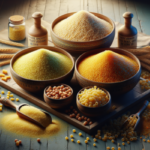Explore the Ultimate Urban Foraging Recipes: Essential Tips for City Foragers
Engaging in foraging in urban environments offers an exhilarating chance to reconnect with nature while discovering a wealth of edible treasures. Whether you are an experienced forager or just beginning this fulfilling hobby, mastering the fundamental skills is vital. This includes accurately identifying edible plants and understanding the legal guidelines surrounding foraging. This detailed guide is designed to provide you with all the necessary knowledge to navigate the exciting world of urban foraging confidently.
Become Proficient in Identifying Edible Plants in Urban Environments

Urban environments, ranging from parks and community gardens to private backyards, are often rich with a diverse selection of edible plants. The primary step toward successful urban foraging is to develop your skills in accurately identifying these plants. Among the most commonly foraged are dandelions, chickweed, and wild garlic, each offering distinct flavors and health benefits.
Dandelions are one of the most recognizable foraging finds, characterized by their bright yellow flowers and jagged leaves. Both the leaves and flowers are edible, with a slightly bitter flavor that enhances salads and herbal teas. In contrast, chickweed presents a milder taste and can be easily added to salads or pureed into a delicious pesto. Additionally, wild garlic, identifiable by its strong aroma and green leaves, adds a delightful flavor dimension to a variety of dishes.
To forage safely, it is essential to recognize plants that may resemble toxic varieties. For instance, some wildflowers can closely mimic edible species, making it wise to consult a reliable foraging guide or mobile application. Joining local foraging groups or participating in workshops can significantly enhance your plant identification skills, empowering you to forage confidently and safely.
Gather Essential Tools and Safety Gear for Effective Urban Foraging
Equipping yourself with the right tools can significantly enhance your foraging experience. A sturdy basket or reusable bag is crucial for collecting your finds, allowing the plants to breathe and minimizing spoilage. A small trowel or knife is essential for digging up root vegetables or cutting herbs efficiently. Additionally, having a pair of scissors can be invaluable when harvesting fragile plants without causing damage.
Your safety should always be a priority; wearing gloves can protect your hands from thorns or irritants, while sturdy shoes offer protection against uneven terrain. It is also wise to carry a first aid kit for minor injuries during your foraging adventures. Always forage during daylight hours in safe locations, and avoid areas near roads or industrial sites where potential contamination could be a concern.
Moreover, keeping a foraging guidebook handy can assist in plant identification, ensuring that what you collect is safe for consumption. Familiarizing yourself with local flora and fauna will not only improve your foraging skills but also deepen your appreciation for the urban ecosystem around you.
Understand Legal Guidelines and Practice Ethical Foraging
Before you embark on your urban foraging journey, it is crucial to become acquainted with the legal frameworks that govern foraging in your area. Different states in Australia have varying regulations regarding what can be foraged and where foraging is permissible. Some public parks may entirely prohibit foraging, while others might have specific guidelines on acceptable practices. Always verify local laws and regulations to avoid fines or legal complications.
Equally important are ethical foraging practices. Strive to adhere to the principle of leaving no trace when foraging; take only what you need. This approach ensures that plants can regenerate naturally and continue to thrive in their environment. Be conscious of over-harvesting from any single area and take care to avoid disturbing any endangered species.
Engaging with local foraging communities can provide invaluable insights into ethical foraging practices. Many foraging groups promote sustainable methods and share knowledge on how to forage responsibly, contributing positively to the preservation of urban ecosystems.
Transform Your Foraged Ingredients into Culinary Masterpieces: Top Recipes for Urban Finds

After collecting your foraged treasures, the next thrilling step is to transform these ingredients into delectable dishes that highlight the vibrant flavors of the urban environment. With a sprinkle of creativity, you can elevate your foraged findings into gourmet culinary creations that are sure to impress family and friends alike.
Experience the Richness of Dandelion and Wild Mushroom Risotto
This exquisite recipe combines the earthy flavors of wild mushrooms with the slightly bitter notes of dandelion greens. Start by sautéing finely chopped onions and garlic in a splash of olive oil until fragrant. Next, add your freshly foraged mushrooms, allowing them to brown slightly and release their natural flavors. Introduce Arborio rice to the pan, ensuring it is well-coated in oil before gradually adding vegetable broth while stirring continuously.
As the rice simmers, fold in your freshly chopped dandelion greens. The greens will wilt and impart a touch of bitterness, beautifully balancing the dish. To finish, generously sprinkle with Parmesan cheese and a squeeze of lemon juice to enhance the overall flavors. This urban foraging recipe not only showcases your finds but also impresses with its depth and richness, making it a standout dish for any dinner table.
Enjoy a Cozy Nettle Soup Enhanced with Urban Herbs
Nettles are often underrated due to their sting; however, once cooked, they transform into a nutrient-dense ingredient ideal for hearty soups. Begin by sautéing chopped onions and garlic until they are soft and aromatic. Next, add your foraged nettles, allowing them to wilt before pouring in vegetable stock and letting the mixture simmer for approximately 20 minutes.
Once the soup has cooked, blend the mixture until it reaches a smooth and creamy consistency, then stir in a variety of urban herbs such as parsley or wild mint to enhance the freshness. This creamy nettle soup not only provides comfort but also serves as a fantastic way to incorporate foraged greens into your diet, offering a delightful and nutritious option for any meal.
Create Foraged Berry and Hibiscus Jam for Sweet Indulgence

Capitalize on the sweetness of foraged berries by making a delightful homemade jam. Start by combining your freshly foraged blackberries or mulberries with sugar, lemon juice, and dried hibiscus flowers in a saucepan. Bring this mixture to a boil, then reduce the heat and let it simmer, stirring until the berries break down and the mixture thickens into a luscious jam.
After cooling, carefully transfer the jam into sterilized jars for storage. This vibrant jam is perfect for spreading on toast, dolloping onto desserts, or simply enjoying as a unique showcase of your urban foraging finds.
Innovative Applications for Common Urban Foraging Finds: Expand Your Culinary Skills
Urban foraging goes beyond cooking; it opens up a world of creative possibilities. From crafting soothing teas to formulating natural skincare products, the edible plants you encounter can be utilized in innovative ways that honor their natural beauty and health benefits.
Craft Delightful Urban Foraged Teas and Infusions
Creating tea from foraged plants is a delightful method to enjoy the unique flavors of your surroundings. Consider using dandelion leaves, which brew into a soothing herbal tea when steeped in hot water. You can also experiment with wild mint for a refreshing infusion or hibiscus flowers for a tangy, fruity tea.
To prepare your tea, gather your foraged leaves or flowers, rinse them gently, and steep them in boiling water for about 5-10 minutes. Strain the infusion and savor it hot or iced. Enhancing your tea with honey or lemon can elevate the flavor, transforming your foraged tea into a comforting beverage and a unique showcase of urban ingredients.
Craft Unique Items Using Urban Foraged Materials
Urban foraging can ignite creativity beyond the culinary realm. Many foraged plants can be transformed into natural fabrics, handmade paper, or vibrant craft dyes. For instance, avocado pits and skins yield a lovely pink hue, while turmeric provides a vivid yellow color.
Gather your materials and prepare the dye by simmering the plant matter in water. Strain the mixture and use the resulting liquid to dye your selected fabric or paper. This sustainable approach reduces waste while beautifully integrating nature into your creative projects.
Explore Urban Foraged Skincare Recipes for Natural Beauty
The benefits of urban plants extend into skincare as well. Numerous foraged ingredients, such as calendula flowers and chickweed, have soothing properties that can be harnessed in homemade skincare products.
To create a simple herbal salve, gently heat olive oil alongside your chosen herbs for a few hours. Strain the mixture and blend it with beeswax to create a nourishing balm. This salve serves as an excellent remedy for dry skin and minor irritations, showcasing the versatility of urban foraging and the healing power of nature in our daily lives.
Seasonal Foraging Guide for Australian Cities: Top Recipes for Urban Foraging Finds
The beauty of urban foraging lies in its seasonality. Each season brings unique plants and ingredients to discover, making it essential to adapt your foraging practices throughout the year.
Spring Foraging Adventures in Melbourne: Discover Edible Delights
Springtime in Melbourne heralds a bounty of edible delights. Dandelions and wild mustard greens begin to emerge, making them ideal candidates for salads and pestos. Parks throughout the city often teem with tender young nettles, perfect for soups or sautéed dishes.
Consider visiting the Royal Botanic Gardens or local parks to seek out a variety of foraged goods. Incorporating these seasonal finds into your meals not only enhances your diet but also fosters a deeper connection with the natural rhythms of the urban landscape.
Summer Foraging Opportunities in Sydney: Savor the Sweetness
Summer in Sydney offers a colorful array of foraged fruits. Blackberries, mulberries, and wild figs are often plentiful, providing a delightful sweet treat on warm days. These fruits can be transformed into jams or desserts or simply enjoyed fresh from the vine.
Look for foraging spots along the coast or in local parks, keeping hydration in mind as you explore. Summer is also an excellent time to experiment with herbs such as wild fennel or mint, which thrive in the balmy weather.
Autumn Foraging Treasures in Brisbane: Uncover Edible Gems
As the leaves transition in Brisbane, foragers can uncover a treasure trove of edible plants. Autumn presents an excellent opportunity to seek out mushrooms, various nuts, and seeds. Acorns, for example, can be transformed into flour or incorporated into savory dishes.
Explore local bushland areas and parks, keeping an eye out for seasonal offerings. This time of year is also ideal for experimenting with foraged ingredients in hearty autumn recipes, such as soups and stews, celebrating the rich flavors of the season.
Community Engagement and Sustainability Insights: Top Recipes for Urban Foraging Finds
Connecting with your community is a vital aspect of urban foraging. By engaging with fellow foragers, you can expand your knowledge and share the joy of discovering local ingredients.
Join Urban Foraging Groups Across Australia: Connect and Learn
Becoming a member of local foraging groups can significantly enhance your foraging experience. These communities often organize workshops, group foraging excursions, and knowledge-sharing sessions. Participating in these events allows you to learn from seasoned foragers and gain valuable insights into local flora.
Many groups also advocate for sustainable practices, educating their members about the importance of ethical foraging. Connecting with others who share your passion foraging can foster friendships and create a supportive network.
Embrace Sustainable Foraging Practices: Protecting Our Environment
At the core of responsible foraging is sustainability. Always adhere to the “one for me, one for the earth” principle—take only what you need and leave enough for the plants to regenerate. Familiarize yourself with local ecosystems and remain mindful of the impact of foraging on them.
Consider maintaining a notebook to track your foraging spots and the plants you discover. This practice not only helps you remember where to return but also encourages mindfulness regarding the resources you are utilizing. By foraging ethically, you contribute to preserving urban environments for generations to come.
Share Your Foraging Discoveries: Community Recipes and Events
Participating in community events highlights the joy of sharing your foraged finds. Many urban areas host potlucks or recipe exchanges where foragers can showcase their culinary creations. By sharing recipes that incorporate foraged ingredients, you foster community spirit and encourage others to explore the world of urban foraging.
Consider hosting your own foraging dinner party, inviting friends to bring their unique finds and share dishes. This collaborative approach not only celebrates the bounty of urban foraging but also strengthens community ties and promotes sustainable practices.
Exploring Health Benefits and Nutritional Value: Top Recipes for Urban Foraging Finds
Urban foraging is not just a delightful activity; it also promotes a healthy lifestyle. Many foraged plants offer substantial nutritional benefits that can improve your overall well-being.
Unlock the Nutritional Benefits of Common Urban Foraged Plants
Many plants typically found in urban environments are packed with vitamins and minerals. For instance, dandelion greens are rich in vitamins A, C, and K, along with essential minerals like calcium and iron. Nettles are particularly celebrated for their high iron content and anti-inflammatory properties, making them a nutritional powerhouse.
Incorporating these plants into your meals can provide a natural boost to your immune system and overall health. By understanding the nutritional profiles of your foraged finds, you can make informed decisions that positively impact your well-being.
Integrating Foraged Foods into a Balanced Diet: Enhance Your Meals
Adding foraged foods to your daily meals not only boosts your nutrition but also introduces unique and exciting flavors. Consider mixing wild greens into salads, using foraged mushrooms in stir-fries, or blending berries into smoothies. The key lies in balancing foraged ingredients with other food groups to achieve a well-rounded diet.
Experimenting with new recipes that highlight your foraged finds can keep your meals vibrant and nutritious. By making foraged foods a regular component of your cooking, you can explore new tastes while fully appreciating their health benefits.
Foraging for Wellness: Discover Urban Plants with Medicinal Properties
Many urban plants possess medicinal properties that support health and wellness. For example, plantain leaves are known for their wound-healing capabilities, while elderberries are recognized for boosting immunity and alleviating cold symptoms.
When foraging, take the time to learn about the medicinal uses of the plants you encounter. Incorporating these plants into your wellness routine can provide natural remedies that complement your overall health goals.
From Foraging to Fine Dining: Top Recipes for Urban Foraging Finds
The culinary world increasingly acknowledges the value of foraged ingredients, with top chefs incorporating them into their menus. This trend highlights the unique flavors and sustainable practices that urban foraging embodies.
Urban Foraged Ingredients Featured in High-End Restaurants: The Farm-to-Table Movement
Many upscale restaurants in Australia are embracing the farm-to-table philosophy by integrating urban foraged ingredients into their culinary creations. Chefs are experimenting with locally sourced plants, infusing their menus with distinctive flavors harvested from the wild.
Foraged ingredients such as wild herbs, mushrooms, and edible flowers add a gourmet flair to dishes, attracting food enthusiasts who appreciate the connection between their meals and the environment. Dining at these establishments not only offers a delightful experience but also supports sustainable practices within the culinary industry.
Host a Foraged Food Dinner Party to Celebrate Your Finds: Connect and Share
A foraged food dinner party is an excellent opportunity to celebrate your foraging successes with friends and family. Start by planning a menu that showcases dishes derived from your foraged ingredients, such as wild mushroom risotto or nettle soup.
Encourage your guests to bring along their foraged finds, fostering a collaborative and interactive atmosphere. Set the table with a nature-inspired theme, using elements from your foraging adventures, like wildflowers or herbs as centerpieces. This immersive experience not only showcases the flavors of urban foraging but also creates lasting memories.
Crafting Foraging-Inspired Cocktails and Beverages: Elevate Your Drinks
Foraged ingredients can also enhance your beverages, creating unique cocktails that celebrate the distinctive flavors of the urban landscape. Consider infusing spirits with wild herbs or crafting syrups from foraged berries and flowers.
A refreshing cocktail might be created by muddling wild mint leaves with sugar and lime, then mixing it with gin and tonic. The result is a vibrant drink that encapsulates the essence of your foraging endeavors, making it perfect for gatherings or special occasions.
Expand Your Knowledge with Educational Resources and Further Learning: Enhance Your Skills
As urban foraging continues to gain traction, a wealth of resources is available to enhance your understanding and skills. From informative books to engaging online courses, there are numerous avenues to deepen your knowledge.
Essential Books and Guides on Urban Foraging in Australia: Your Go-To Resources
A variety of excellent books focus on urban foraging in Australia, offering insights into local plant identification, effective foraging techniques, and delicious recipes. Titles such as Foraging: A Guide to the Wild Foods of Australia and The Edible City provide practical advice and inspiration for both novice and experienced foragers.
These guides help you identify edible plants while promoting sustainable practices and ethical foraging methods. Investing in a reliable foraging book can be a significant step toward becoming a more knowledgeable forager.
Explore Online Courses and Workshops on Urban Foraging: Learn at Your Own Pace
Several online platforms offer courses and workshops dedicated to urban foraging, providing flexibility for those wishing to learn at their own pace. These programs typically cover essential topics such as plant identification, culinary uses, and ethical foraging practices.
Enrolling in an online course can significantly enhance your skills, allowing you to connect with instructors and fellow students who share your passion for foraging. Many courses also grant access to exclusive resources, enriching your overall learning experience.
Connect with Experts and Mentors in Urban Foraging: Build Your Network
Finding a mentor within the urban foraging community can greatly enhance your skills and knowledge. Numerous experienced foragers are eager to share their expertise and provide guidance on plant identification, effective foraging techniques, and sustainable practices.
Seek out local workshops or foraging groups where you can meet these experts. Engaging with mentors not only accelerates your learning but also cultivates a sense of community within the foraging world, fostering connections and friendships that can last a lifetime.
Frequently Asked Questions about Urban Foraging: Your Queries Answered
What is urban foraging all about?
Urban foraging involves searching for edible plants and mushrooms in urban settings, such as parks and gardens. It provides individuals with a unique opportunity to connect with nature while discovering local food sources.
Is it safe to consume foraged plants?
Safety largely depends on accurate identification. Always ensure you can correctly identify plants and confirm their safety for consumption, as some may have toxic lookalikes.
What tools are essential for urban foraging?
Key tools include a durable basket for collecting plants, a trowel or knife for harvesting, gloves for hand protection, and a foraging guide to identify plants.
Are there legal restrictions regarding foraging in Australia?
Yes, regulations vary based on location. Always verify local laws concerning foraging in parks or public spaces to ensure compliance with ethical practices.
Can I forage in my own backyard?
Absolutely! Numerous edible plants thrive in gardens and backyards. Just ensure that you are not using any chemicals or pesticides that could contaminate your finds.
What are some common edible plants found in urban areas?
Depending on the season and region, common urban foraged plants include dandelions, chickweed, wild garlic, nettles, and various types of berries.
How can I use foraged ingredients in cooking?
Foraged ingredients can be integrated into salads, soups, jams, and cocktails, adding unique flavors and nutritional benefits to your meals.
What sustainable practices should I follow while foraging?
Only take what you need, avoid over-harvesting, and ensure there are enough plants left for regeneration. Educating yourself about local ecosystems is crucial for responsible foraging.
Where can I find more information on urban foraging?
Books, online courses, and local foraging groups offer excellent resources. Engaging with community members can also enhance your knowledge and skills.
What are the health benefits of foraged foods?
Foraged foods are often rich in vitamins, minerals, and antioxidants, providing numerous health benefits while adding nutritional diversity to your diet.
Connect with us on Facebook!
The post Explore the Ultimate Urban Foraging Recipes: Culinary Adventures appeared first on https://cookinggods.com
The Article Urban Foraging Finds: Exciting Recipes for Culinary Adventures Was Found On https://limitsofstrategy.com

